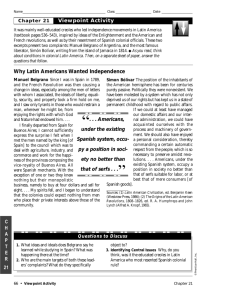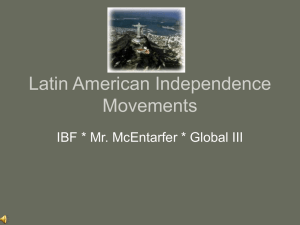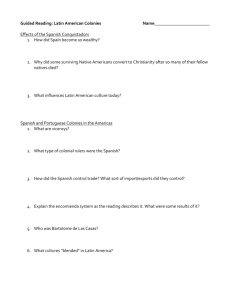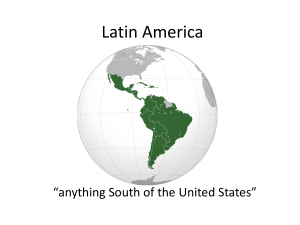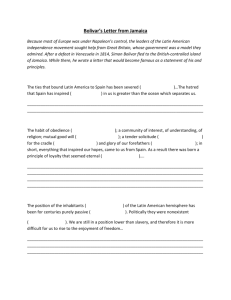Revolution in South America - Leleua Loupe
advertisement
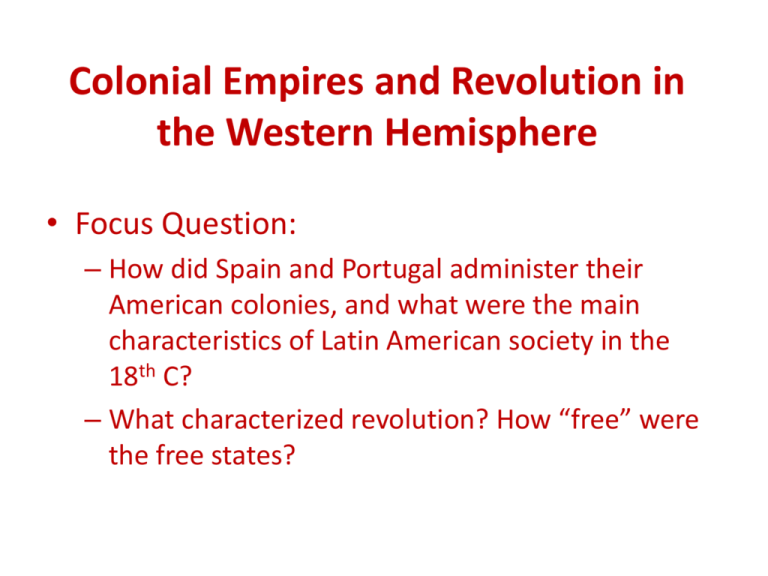
Colonial Empires and Revolution in the Western Hemisphere • Focus Question: – How did Spain and Portugal administer their American colonies, and what were the main characteristics of Latin American society in the 18th C? – What characterized revolution? How “free” were the free states? The Society of Latin America • 16th Century Latin America – Portugal: Brazil – Spain: Central America, most of South America • Multiracial society/Racial Caste System – Mestizos: Intermarriage between Spanish and indigenous peoples – Mulattoes: Intermarriage between Europeans and Africans – Zambos: indigenous and African descent The Society of Latin America • The Economic Foundations – Gold and Silver – Agriculture • Estates & Peons – Trade • Colonies a source of raw materials for exports – Gold, silver, diamonds, sugar, animal hides Aboriginal Slavery Pack train of llamas Mines of Potosi, Peru, 1590 African Slavery • Middle Passage • or System of Asiento • 16th C 75,000 Africans – 18th C 9.5 million enslaved Palenques & Quilombos • La Republica de Zambos, 1599 • 16th C portrait of Don Francisco de Arobe, black ruler of an Ecuadorian province Commerce, Smuggling, Piracy • Casa de Contratacion (house of trade) • est. 1503 in Seville • Wealthier merchants of Seville and Cadiz – Maintained trade monopoly • Seville Merchant oligarchy or guilds – kept the colonial markets under stocked – forced colonists to pay exorbitant prices for all European goods acquired through legal channels. • generated colonial discontent and stimulated the growth of contraband trade. England’s Challenge to Spain • England’s Challenge to Spain: Piracy: • Queen Elizabeth – Sir Francis Drake,1577 • “singe the King of Spain’s beard” – seized treasure ships – ravaged colonial towns • Treaty of Madrid in 1670 between England and Spain. 1573 Spanish Inquisition • Persuasion • Coercion • Natives that practiced tradition were charged with heresy • punished – Hanged or burned at the stake Legacy of Inquisition? • Methods of repression continued by Totalitarian Regimes & Police States – – – – – – – – – – Creation of racial & religious Ghettos Forcible wearing of badges of shame Formal state & religious propaganda Spying Seizure of property Intimidation & torture Sexual humiliation Good cop/bad cop routine Physical restraint Separation of families • No recognition of natural or civil rights • Threat and repression of Humanity New Laws of the Indies (1542) • Dominican bishop Antonio de Valdivieso of Nicaragua – tried to enforce the abolition of indigenous slavery by the New Laws (assassinated 1550) • Franciscan Toribio de Benavente or Motolinia (Realist or moderate) – Believed the encomienda was necessary for the prosperity and security of the indies Institutions of Conquest • • • • Mission, Presidio, Pueblo, Rancho Encomienda Repartimiento or mita Slavery – New political climate marked by a growing belief in the constitutional inferiority of indigos peoples The Mission • The Mission – The Franciscans and Other Mendicant Orders – Salvation in return for labor The Mission (1986) –The Jesuit missionary Father Gabriel (Jeremy Irons) with the Guaraní´ Indians of Paraguay before their slaughter by Portuguese troops. © Warner Brothers/Courtesy Everett Collection Wards of the Friars • Francis Guest – As is commonly known, Spanish law made the missionaries the legal guardians of their Indian converts. – In virtue of their conversion and baptism the neophytes became the wards of the friar • Lands confiscated • Neophytes became property of the friars Components of the Mission System: the Pueblo • The Pueblo – Agricultural Towns – Indian Labor – Hope to Decrease Reliance on Mexico and Missions Components of the Mission System: the Presidio The Presidio • Forts to Protect the Mission • Garrisons Return Fugitives • Garrisons Capture New Neophytes • Four Built • Weak Militarily Components of the Mission System: the Rancho The Rancho – Mission Herds – Use Indian Labor – Major Source of Wealth in Mission System – Give Missions Power over Spanish Government Forced System of Labor • Excessive confining work – Brick Manufacture • Men made adobe bricks • Women aided in transporting bricks & tiles – Weaving lucrative for the mission • Women & Children employed in processing wool and weaving – Evidence of piece rate system, paid “in kind” 18th C Perspectives • French Explorer Jean Francois Galaup Comte de La Perouse – Likened the Indians of Mission San Carlos in 1786 to the Slaves of Santo Domingo • Descriptions lf serious charges of cruelty – George Vancouver Expeditions – Naturalist Archibald Menzies, 1792 – Documents & letters authored by military authorities in 1785 & cited by George Bancroft Native Resistance “Cooperation” Passive Resistance Fugitivism Active Resistance Revolt Homicide Raids on livestock Revitalization Resistance • Indigenous Women – They enjoyed economic importance as producers and traders of goods – countered male abuse – played leading roles in the organization o resistance Theodor de Bry (1528 – 1598) Impact of the Mission System and Spanish Settlement Land Population Culture Mission Santa Barbara Latin America: 19th & early 20th C • Q: What role did liberalism and nationalism play in Latin America Between 1800 and 1870? • Q: What were the major economic, social and political trends in Latin American in the late 19th and early 20th Centuries. Challenge to Spanish & Portuguese Colonialism • Influence of Enlightenment ideals & upheavals in the Napoleonic era – The Wars for Independence • Creole Elites: descendants of Europeans • Simon Bolivar of Venezuela • Jose de San Martin of Argentina – Principle of Equality of all people under law – Free trade – Free press » Did not apply to everyone Toussaint L’Ouverture,Haiti, 1804 © North Wind Picture Archives Nationalistic Revolts • Mexican Independence, 1810 – Miguel Hidalgo Y Costilla – Represented a peoples revolution • September 16, 1910 crushed • Creoles & Peninsulars united to defeat the popular revolution – Augustin de Iturbide, first emperor of Mexico, 1821 • No political or economic changes “Liberator” of South America • Venezuela (1819) •Colombia •Ecuador •Perus •Simon Bolivar leading his troops across the Andes in 1823 to fight in Peru © SuperStock “Liberators” of South America •San Jose Martyn is shown leading his troops at the Battle of Chacabuco, Chile, 1817. By1824: “Free States”: Uruguay, Paraguay, Colombia, Venezuela, Argentina, Bolivia Chile • Latin America in the First Half of the Nineteenth Century Nation Building • The Difficulties of Nation Building (1830-187) – Consequences of Wars for independence • Loss of population, property and livestock • Boundary disputes • Poor transportation and communication challenged unity and fostered regionalism • European & American intervention • Monroe Doctrine, 1823 Political Obstacles • Different types of leadership • Caudillos (leaders) of New Republics – National Caudillos • Autocrats: Supported elites and controlled state revenues, favored centralized power and unity of states – worked against the majority’s interests – Sometimes were modernizers in that they build infrastructure, canal, ports, schools, Economic Patterns • Great Britain & America dominated Latin American economy – Raw materials & new Markets • Incredible disparity of wealth – Landed elite • Land basis of wealth, social prestige, political power • Controlled government, courts • Maintained system of debt peonage Foreign Investments • 1870 – 1913 foreign investments boomed – British investment: • Growth from 85 to 757 million pound, 2/3 of all foreign investments – Railroads – Mining – Public utilities • Slavery technically abolished in 1888 • Most people remained subservient and dependent on elite and foreigners Catholic Church • Enormous land holdings-Exercised great power • Clerics took position in new governments following independence – Considerable influence • Conflict of church & state – Liberals wanted to curtail powers of church – Conservatives hoped to maintain privileges and power of church Working Class • Growth of labor unions – Radical unions advocated use of the general strike as an instrument for change • Lack of suffrage • Political Change after 1870 – Landed Elite • Controlled government • produced constitutions similar to those of the US and Europe • limited suffrage maintained concentration of power Dictators • Some landowners made use of dictators to maintain the interests of the ruling elite. – Porfirio Diaz , Mexico, Ruled 1876 – 1910, • established a conservative, centralized government – support of the army, foreign capitalists, large landowners, and the catholic church. • Consequences of Dictatorship: – real wages of working class declined, – 95% of rural population owned no land, – 1000 families owned the land. Economy after 1870 • Growth of economy – Modernization & wealth a veneer – Enjoyed by the wealthy minority • Rural elites dominated workers – Indians impoverished – Debt servitude – Dependent on foreigners Emiliano Zapata •Liberal landowner Francisco Madero, forced Diaz from power •Madera’s ineffectiveness to carry out sufficient reform triggered a demand for agrarian reform led by Zapata © Snark/Art Resource, NY Mexican Revolution, 1910 • He aroused the revolutionary impulse of landless – Seized the haciendas (plantations) of the wealthy • Impact of revolution – destroyed the economy – new constitution in 1917 United States Intervention • United States emergence as a world power – interfered into the economies of Latin America • The Spanish American War 1898 – Platt Amendment (1901) Cuba – Foraker Act (1900) Puerto Rico • Between 1898 – 1934 – sent military forces to Cuba, Mexico, Guatemala, Honduras, Nicaragua, Panama, Columbia, Haiti, and the Dominica Republic Imperialists • Take up the White Man's burden-Send forth the best ye breed-Go, bind your sons to exile To serve your captives' need; To wait, in heavy harness, On fluttered folk and wild-Your new-caught sullen peoples, Half devil and half child..." • Rudyard Kipling - McClure's Magazine 12 (Feb. 1899). Zionsim Palestine in 1900
